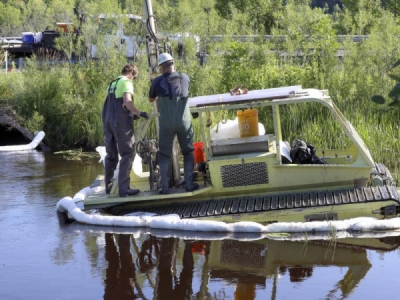
Posted on August 11, 2020
Two men aboard an amphibious Marsh Master buggy collect a sediment sample from a small pond between Perch Lake and the St. Louis River Tuesday. A $7 million project aims to reconnect the 30-acre lake to the St. Louis River, restoring it for fish and other wildlife.
Goal of $7 million project is more and better habitat for fish, waterfowl and other critters.
Perch Lake in western Duluth isn’t much more than a mud pit now, shallow, filled with sediment and so low in oxygen that fish can’t survive for much of the year.
As far as fish go, you’d be lucky to find a perch in there.
But a $7 million project headed by the U.S. Army Corps of Engineers aims to change that — to make the 30-acre impoundment a bastion for fish by reconnecting it to the St. Louis River and restoring it for walleye, sturgeon, muskellunge and ducks.
“Right now there isn’t enough oxygen for anything to live in there most of the year. Especially in winter,” said Melissa Sjolund, who is overseeing the project for the Minnesota Department of Natural Resources. “It is so shallow and so filled with organic matter, muck, that it freezes out.”

Minnesota Highway 23 and an old railroad bed separate Perch Lake (background) from the St. Louis River. (Steve Kuchera / skuchera@duluthnews.com)
Perch Lake didn’t become a lake until construction of first a railroad track and then Minnesota Highway 23 cut it off from the rest of the St. Louis River estuary. Before that it was part of the river’s ebbs and flows, a backwater bend connected by channels and revived with floods and high water — part of the river’s ecosystem and likely great habitat for fish, waterfowl and wildlife.
Now, except for a single 48-inch culvert, Perch Lake doesn’t have much relationship with the river.
This week contractors hired by the U.S. Army Corps of Engineers began baseline sediment samples and geotechnical samples in and around Perch Lake. They want to find the most stable places under the roadway for new openings between the lake and river.
Construction of the new waterway connections is expected in 2021 with public input sessions planned before any work starts.

A crew works at a drilling rig along Minnesota Highway 23 between Perch Lake and the St. Louis River Tuesday. (Steve Kuchera / skuchera@duluthnews.com)
“It looks like the best options will be retaining the current culvert as the upstream connection and then adding one or more openings, probably culverts, downstream,’’ Sjolund said. “We’re working with MNDOT to find the least intrusive way to do this that doesn’t impact the road but also accomplishes our goals for restoring Perch Lake.”
In addition to the new water routes between the lake and river, the project includes dredging upwards of 100,000 cubic yards of muck out of the lake that has accumulated over the last century with no natural flow to move it on. That’s about 7,142 average sized dump truck loads.
The end result will be both shallow and deep water habitat for small and big fish and shoreline wetland habitat for waterfowl and other critters.

A sediment sample is secured to the cab roof of an amphibious Marsh Master buggy Tuesday. (Steve Kuchera / skuchera@duluthnews.com)
Funding already has been approved from both state and federal sources, part of the massive, ongoing cleanup of the St. Louis River Area of Concern — a cleanup gradually occurring all the way from the Thomson Reservoir above the dams to Minnesota Slip close to Lake Superior.
Federal funding is part of the Great Lakes Restoration Initiative while state funding comes from the Minnesota Outdoor Heritage Fund.
For more information on the effort to restore the St. Louis River estuary go to www.dnr.state.mn.us/st-louis-river-restoration/
Source: duluthnewstribune





